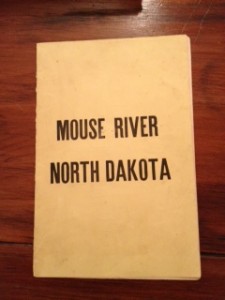This plain little booklet is a rare item regarding North Dakota cattle raising. One of the Merrill Aristocrats. Rated by some as the hardest of the Aristocrats to find. If you see one grab it!
Here is my description of it:
Warren, C. H. Mouse River Cattle Raising. Chicago: Poole Bros. Printing for the St. Paul, Minneapolis and Manitoba Railway Co. N.d. (Circa 1886). Yellow wraps. Map of the St. Paul, Minneapolis and Manitoba Railway on the rear wrapper. 12 pp.
Herd 1683: “Scarce.” A Merrill Aristocrat. World Cat lists eight copies. “Deals with the pioneer history and conditions of the cattle industry in the Red River and Mouse River regions of North Dakota from 1870.” — Adams. Cover title: “Mouse River North Dakota.” Adams dates it to 1885, but the text refers to a report on the public lands in 1886. “An excessively rare item. … one of the hardest of all Merrill Aristocrats to locate.” — Swinford. Provides detailed advice to the prospective emigrant on “Mouse River Cattle Raising” and “How to get a Free Farm in North Dakota,” as well as statistical information on population, resources, climate, railroads, the melting away of public lands, etc. The Mouse River region is in the north-central part of North Dakota, and this pamphlet was likely partly financed by the St. Paul, Minneapolis and Manitoba Railway, which had just completed a rail line into that area. A frank but enthusiastic discussion, culled from a variety of western newspapers, of the economic prospects and suitability for cattle raising, of the Mouse River region and North Dakota in general. The author writes: “Cattle-raising has passed the experimental stage in the Mouse river country and, for that matter, all through North Dakota. It would seem almost incredible to stockmen in the ‘corn belt’ to be told that cattle and horses are grown and fattened on the Mouse river on hay alone, but such is the fact.” “An extremely rare North Dakota promotional pamphlet, and rarity of the cattle industry in North Dakota, this is only the second copy we have handled in twenty-five years.” — Reese.

